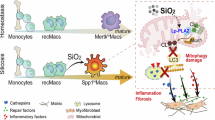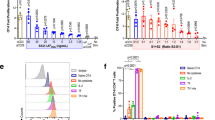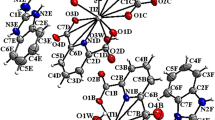Abstract
In the present study we demonstrated that CD95L cross-linking generated reverse signalling in the mouse derived Sertoli cell line TM4. Treatment of TM4 cells with mAb anti-CD95L induced activation of the cytosolic phospholipase A2 (cPLA2). Cytosolic PLA2 activation was controlled by the MAPK pathway as indicated by the ability of the specific MEK inhibitor, PD098059, to abolish cPLA2 activation. In addition, Western blot experiments showed a rapid increase in phosphorylated Erk1/2 following CD95L cross-linking, while no effect on the phosphorylation of other MAPK, p38 or JNK, was observed. CD95L cross-linking by mAb increased the levels of soluble CD95L and apoptotic activity of TM4 cell supernatants, which was blocked by co-incubation with the PLA2 inhibitor, AACOCF3 or PD098059. Finally, pre-treatment of TM4 cells with AACOCF3 or PD098059 completely abolished TM4-induced apoptosis of Jurkat T cells, thus indicating that the Erk/cPLA2 pathway is required for CD95L-induced apoptosis. Cell Death and Differentiation (2000) 7, 916–924
Similar content being viewed by others
Log in or create a free account to read this content
Gain free access to this article, as well as selected content from this journal and more on nature.com
or
Abbreviations
- CD95L:
-
CD95 ligand
- PLA2:
-
phospholipase A2
- MAPK:
-
mitogen activated protein kinase
- MEK:
-
MAPK kinase
- Erk:
-
extracellular signal-regulated kinase
- JNK:
-
c-Jun N-terminal kinase
- DAG:
-
diacylglycerol
- TNF:
-
tumour necrosis factor
References
French LE, Hahne M, Viard I, Radlgruber G, Zanone R, Becker K, Muller C and Tschopp J . 1996 Fas and Fas ligand in embryos and adult mice: ligand expression in several immune-privileged tissues and coexpression in adult tissues characterized by apoptotic cell turnover. J. Cell Biol. 133: 335–343
Rieux-Laucat F, Le Deist F, Hivroz C, Roberts IAG, Debatin KM, Fischer A and de Villarty JP . 1995 Mutations in Fas associated with human lymphoproliferative syndrome and autoimmunity. Science 268: 1347–1349
Runic R, Lockwood CJ, Di Pasquale B and Guller S . 1996 Expression of Fas ligand by human cytorophoblasts: implication in placentation and fetal survival. J. Clin. Endocr. Metab. 81: 3119–3122
Ramsdell F, Seaman MS, Miller RE, Tough TW, Alderson MR and Lynch DH . 1994 gld/gld mice are unable to express a functional ligand for Fas. Eur. J. Immunol. 24: 928–933
Gillette-Ferguson I and Sidman CL . 1994 A specific intercellular pathway of apoptotic cell death is defective in the mature peripheral T cells of autoimmune lpr and gld mice. Eur. J. Immunol. 24: 1181–1185
Bellgrau D, Gold D, Selawry H, Moore J, Franzusoff A and Duke RC . 1995 A role for CD95 ligand in preventing graft rejection. Nature 377: 630–632
McClure RF, Heppelmann CJ and Paya CV . 1999 Constitutive Fas ligand gene transcription in Sertoli cells is regulated by SP1. J. Biol. Chem. 274: 7756–7762
Nagata S and Golstein P . 1995 The Fas death factor. Science 267: 1449–1456
Griffith TS and Ferguson TA . 1997 The role of FasL-induced apoptosis in immune privilege. Immunol. Today 18: 240–244
Niehans GA, Brunner T, Frizelle SP, Liston JC, Salerno CT, Knapp DJ, Green DR and Kratzke RA . 1997 Human lung carcinomas express Fas ligand. Cancer Res. 57: 1007–1012
O'Connell J, O'Sullivan GC, Collins JK and Shanahan F . 1996 The Fas counter attack: Fas-mediated T cell killing by colon cancer cells expressing Fas ligand. J. Exp. Med. 184: 1075–1082
Takahashi T, Tanaka M, Brannam CI, Jenkins NA, Copeland NG, Suda T and Nagata S . 1994 Generalized lymphoproliferation disease in mice, caused by a point mutation in the Fas ligand. Cell 76: 969–976
Gillette-Fergusson I and Sidman CL . 1994 A specific intercellular pathway of apoptotic cell death is defective in the mature peripheral T cells of autoimmune lpr and gld mice. Eur. J. Immunol. 24: 1181–1185
Lee J, Richburg JH, Younkin SC and Boekeheide K . 1997 The Fas system is a key regulator of germ cell apoptosis in the testis. Endocrinology 138: 2081–2088
Lee J, Richburg JH, Shipp EB, Meistrich ML and Boekelheide K . 1999 The Fas system, a regulator of testicular germ cell apoptosis, is differentially up-regulated in Sertoli cell versus germ cell injury of the testis. Endocrinology 140: 852–858
Rodriguez I, Ody C, Araki K, Garcia I and Vassalli P . 1997 An early and massive wave of germinal cell apoptosis is required for the development of functional spermatogenesis. EMBO J. 16: 2262–2270
Blanco-Rodriguez J . 1998 A matter of death and life: the significance of germ cell death during spermatogenesis. Int. J. Androl. 21: 236–248
Tapanainen JS, Tilly JL, Vihko KK and Hsueh AJW . 1993 Hormonal control of apoptotic cell death in the testis: gonadotropins and androgens as testicular cell survival factors. Mol. Endocrinol. 7: 643–650
Ross AJ, Waymire KG, Moss JE, Parlow AF, Skinner MK, Russel LD and MacGregor GR . 1998 Testicular degeneration in Bclw-deficient mice. Nature Genet. 18: 251–256
Odorisio T, Rodriguez TA, Evans EP, Clarke AR and Burgoyne PS . 1998 The meiotic checkpoint monitoring synapsis eliminates spermatocytes via p53-independent apoptosis. Nature Genet. 18: 257–261
Allen RD, Marshall JD, Roths JB and Sidman CL . 1990 Differences defined by bone marrow transplantation suggest that lpr and gld are mutations of genes encoding an interacting pair of molecules. J. Exp. Med. 172: 1367–1375
Suda T, Takahashi T, Golstein P and Nagata S . 1993 Molecular cloning and expression of the Fas ligand, a novel member of the tumor necrosis factor family. Cell 75: 1169–1178
Tanaka M, Itai T, Adachi M and Nagata S . 1998 Downregulation of Fas ligand by shedding. Nature Med. 4: 31–36
Watanabe-Fukunaga R, Brannan CI, Itoh N, Yonehara S, Copeland NG, Jenkins NA and Nagata S . 1992 The cDNA structure, expression, and chromosomal assignment of the mouse Fas antigen. J. Immunol. 148: 1274–1279
Cifone MG, De Maria R, Roncaioli P, Rippo MR, Azuma M, Lanier LL, Santoni A and Testi R . 1993 Apoptotic signalling through CD95 (Fas/Apo-1) activates an acidic sphingomyelinase. J. Exp. Med. 177: 1547–1552
Medema JP . 1997 FLICE is activated by association with the CD95 death-inducing signalling complex (DISC). EMBO J. 16: 2794–2804
Cifone MG, Roncaioli P, De Maria R, Camarda G, Santoni A, Ruberti G and Testi R . 1995 Multiple pathways originate at the CD95/APO-1 (CD95) receptor: sequential involvement of phosphatidylcholine-specific phospholipase C and acid sphingomyelinase in the propagation of the apoptotic signal. EMBO J. 14: 5859–5868
Los M, Van de Craen M, Penning LC, Schenk H, Westendorp M, Baeuerle PA, Droge W, Krammer PH, Flers W and Schulze-Osthoff K . 1995 Requirement of an ICE/CED-3 protease for CD95/APO-1-mediated apoptosis. Nature 375: 81–83
Suzuki I and Fink PJ . 1998 Maximal proliferation of cytotoxic T lymphocytes requires reverse signalling through Fas ligand. J. Exp. Med. 187: 123–128
Smith CG, Farrah T and Goodwin RG . 1994 The TNF receptor superfamily of cellular and viral proteins: activation, costimulation, and death. Cell 76: 959–962
Stuber E, Neurath M, Calderhead D, Fell HP and Strober W . 1995 Crosslinking of OX40 ligand, a member of the TNF/NGF cytokine family, induces proliferation and differentiation in murine splenic B cells. Immunity 2: 507–521
Wiley SR, Goodwin RG and Smith CA . 1996 Reverse signalling via CD30 ligand. J. Immunol. 157: 3635–3639
Watt AD, Hunt NH, Wanigasekara Y, Bloomfield G, Wallach D, Roufogalis BD and Chaudhri G . 1999 A casein kinase I motif present in the cytoplasmic domain of members of the tumor necrosis factor ligand family is implicated in “reverse signalling”. EMBO J. 18: 2119–2126
Vignaux F, Vivier E, Malissen B, Depraetere V, Nagata S and Glostein P . 1995 TCR/CD3 coupling to Fas-based cytotoxicity. J. Exp. Med. 181: 781–786
van Essen D, Kikutani H and Gray D . 1995 CD40 ligand-transduced co-stimulation of T cells in the development of helper function. Nature 378: 620–624
Kiener PA, Davis PM, Rankin BM, Klebanoff SJ, Ledbetter JA, Starling GC and Liles WC . 1997 Human monocytic cells contain high levels of intracellular Fas ligand: rapid release following cellular activation. J. Immunol. 159: 1594–1598
Bossi G and Griffiths GM . 1999 Degranulation plays on essential part in regulation cell surface expression of Fas ligand in T cells and natural killer cells. Nature Med. 5: 90–96
Lennartz MR . 1999 Phospholipase and phagocytosis: the role of phospholipid-derived second messengers in phagocytosis. Int. J. Biochem. Cell Biol. 31: 415–430
Leslie CC . 1997 Properties and regulation of cytosolic phospholipase A2 . J. Biol. Chem. 272: 16709–16712
Lin LL, Wartmann M, Lin AY, Knopf JL, Seth A and Davis RJ . 1993 cPLA2 is phosphorylated and activated by MAP kinase. Cell 72: 269–278
Doerfler ME, Weiss J, Clark JD and Elsbach P . 1994 Bacterial lipopolysaccaride primes human neutrophils for enhanced release of arachidonic acid and causes phosphorylation of an 85-kDa cytosolic phospholipase A2 . J. Clin. Invest. 93: 1583–1591
Waterman WH, Molski TFP, Huang C-K, Adams JL and Sha'afi RI . 1996 TNF-α-induced phosphorylation and activation of cytosolic phospholipase A2 are abrogated by an inhibitor of the p38 MAP kinase cascade in human neutrophils. Biochem. J. 319: 17–20
Syrbu IS, Waterman WH, Molski TFP, Nagarkatti D, Hajjar J-J and Sha'afi RI . 1999 Phosphorylation of cytosolic phospholipase A2 and the release of arachidonic acid in human neutrophils. J. Immunol. 162: 2334–2340
Qiu Z-H and Leslie CC . 1994 Protein kinase C-dependent and -independent pathways of mitogen-activated protein kinase activation in macrophages by stimuli that activate phospholipase A2 . J. Biol. Chem. 269: 19480–19487
Borsch-Haubold AG, Kramer RM and Watson SP . 1995 Cytosolic phospholipase A2 is phosphorylated in collagen- and thrombin-stimulated human platelets independent of protein kinase C and mitogen-activated protein kinase. J. Biol. Chem. 270: 25885–25892
Ren R, Mayer BJ, Cicchetti P and Baltimore D . 1993 Identification of a ten-amino acid proline-rich SH3 binding site. Science 259: 1157–1161
Takahashi T, Tanaka M, Inazawa J, Abe T, Suda T and Nagata S . 1994 Human Fas ligand: gene structure, chromosomal localization and species specificity. Int. Immunol. 6: 1567–1574
Hane M, Lowin B, Peitsch M, Becker K and Tschopp J . 1995 Interaction of peptides derived from the Fas ligand with the Fyn-SH3 domain. FEBS Lett. 373: 265–268
Davis RJ . 1993 The mitogen-activated protein kinase signal transduction pathway. J. Biol. Chem. 268: 14553–14556
Schaeffer HJ and Weber MJ . 1999 Mitogen-activated protein kinases: specific messages from ubiquitous messenger. Mol. Cell. Biol. 19: 2435–2444
Martinez-Lorenzo MJ, Alava MA, Anel A, Piñeiro A and Naval J . 1996 Release of preformed Fas ligand in soluble form is the major factor for activation-induced death of jurkat T cells. Immunology 89: 511–517
Tanaka M, Suda T, Takahashi T and Nagata S . 1995 Expression of the functional soluble form of human Fas ligand in activated lymphocytes. EMBO J. 14: 1129–1135
Suda T, Hashimoto H, Tanaka M, Ochi T and Nagata S . 1997 Membrane Fas ligand kills human peripheral blood T lymphocytes, and soluble Fas ligand blocks the killing. J. Exp. Med. 186: 2045–2050
Tanaka M, Suda T, Haze K, Nakamura N, Sato K, Kimura F, Motoyoshi K, Mizuki M, Tagawa S, Ohga S, Hatake K, Drummond AH and Nagata S . 1996 Fas ligand in human serum. Nature Medicine 2: 317–322
Schneider P, Holler N, Bodmer J-L, Hahne M, Frei K, Fontana A and Tschopp J . 1998 Conversion of membrane-bound Fas(CD95) ligand to its soluble form is associated with downregulation of its proapoptotic activity and loss of liver toxicity. J. Exp. Med. 187: 1205–1213
Martinez-Lorenzo MJ, Anel A, Gamen S, Monleón I, Lasierra P, Larrad L, Piñeiro A, Alava MA and Naval J . 1999 Activated human T cells release bioactive Fas ligand and APO2 ligand in microvesicles. J. Immunol. 163: 1274–1281
Ulisse S, Jannini EA, Pepe M, De Matteis S and D'Armiento M . 1992 Thyroid hormone stimulates glucose transport and GLUT1 mRNA in rat Sertoli cells. Mol. Cell. Endocrinol. 87: 131–137
Mather JP . 1980 Establishment and characterization of two distinct mouse testicular epithelial cell lines. Biol. Reprod. 23: 243–252
Chomczynsky P and Sacchi P . 1987 Single step method of RNA isolation by guanidinium thiocyanate-phenol-chloroform extraction. Anal. Biochem. 162: 156–159
Cifone MG, Roncaioli P, Cironi L, Festuccia C, Meccia A, D'Alò S, Botti D and Santoni A . 1997 NKR-P1A stimulation of arachidonate-generating enzymes in rat NK cells is associated with granule release and cytotoxic activity. J. Immunol. 159: 309–317
Cifone MG, D'Alò S, Parroni R, Millimaggi D, Biordi L, Martinotti S and Santoni A . 1999 Interleukin-2-activated rat natural killer cells express inducible nitric oxide synthase that contributes to cytotoxic function and interferon-γ production. Blood 93: 3876–3884
Bligh EG and Dyer WJ . 1995 A rapid method of total lipid extraction and purification. J. Biochem. Physiol. 37: 911–917
Acknowledgements
This work was supported by the Ministero dell'Università e della Ricerca Scientifica e Tecnologica grants (MURST 60%).
Author information
Authors and Affiliations
Corresponding author
Additional information
Edited by M Piacentini
Rights and permissions
About this article
Cite this article
Ulisse, S., Cinque, B., Silvano, G. et al. Erk-dependent cytosolic phospholipase A2 activity is induced by CD95 ligand cross-linking in the mouse derived Sertoli cell line TM4 and is required to trigger apoptosis in CD95 bearing cells. Cell Death Differ 7, 916–924 (2000). https://doi.org/10.1038/sj.cdd.4400716
Received:
Revised:
Accepted:
Published:
Issue date:
DOI: https://doi.org/10.1038/sj.cdd.4400716



